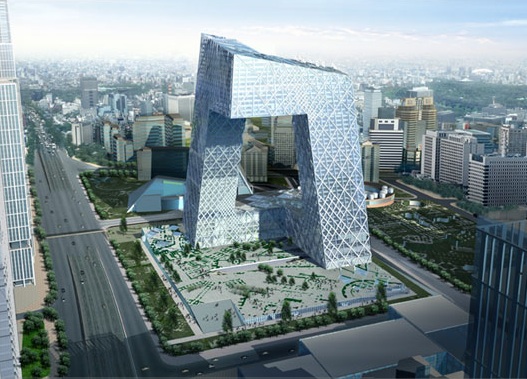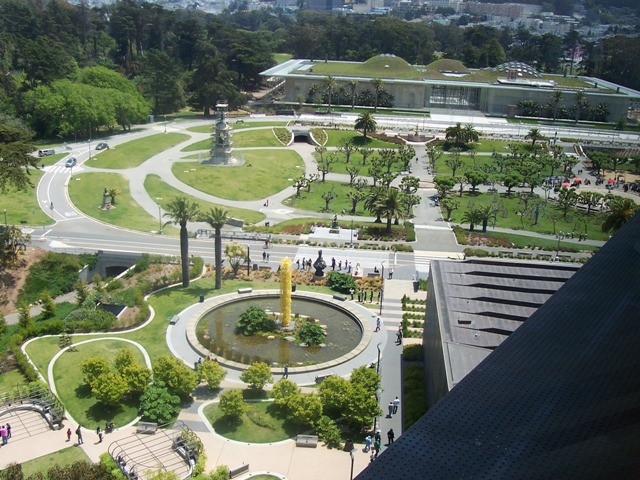Paul Goldberger, the new yorker's architecture critic, lists his favorite buildings of 2008. in new york is olafur eliasson's waterfalls, the new museum, and the eldridge street synagogue. i'm a huge fan of the california academy of sciences, and the CCTC headquarters in (which I had not seen before Goldberger's piece).
Paul Goldberger: Architecture’s Ten Best of 2008
Architectural history will probably treat 2008 more kindly than it deserves to be treated, only because there was architecture to talk about. Never mind that most of the buildings finished over the last twelve months are relics of a time when we actually thought we could afford to build things. The pickings for 2009 are going to be slim, and for 2010 slimmer still. (For that reason, no new designs announced in 2008 are on this year’s list—we’ll save them for when we really need them.) For now, let’s take pleasure in those projects that were started in that ancient era when the Dow was at twelve thousand, and we thought the fun would go on forever.
In Beijing, it didn’t matter what the Dow was, of course, since the Chinese  government’s decision to make itself the world’s leading patron of architecture was dependent on other things, including cheap labor. In time for the 2008 Olympics, the world saw the fruits of China’s decision to put aside nationalism, hire the greatest architects from around the world, and let them do the kind of things they could never afford to do at home. That brought us two of the greatest buildings of the year, Herzog and de Meuron’s extraordinary Olympic Stadium, the stunning steel latticework structure widely known as the Bird’s Nest; and Norman Foster’s Beijing Airport (above right), a project that was not only bigger than any other airport in the world, but more beautiful, more logically laid out, and more quickly built. And the headquarters of CCTV, the Chinese television network, by Rem Koolhaas and Ole Scheeren (below left), of the Office for Metropolitan Architecture—a building which I had thought was going to be a pretentious piece of structural exhibitionism—turned out to be a compelling and exciting piece of structural exhibitionism.
government’s decision to make itself the world’s leading patron of architecture was dependent on other things, including cheap labor. In time for the 2008 Olympics, the world saw the fruits of China’s decision to put aside nationalism, hire the greatest architects from around the world, and let them do the kind of things they could never afford to do at home. That brought us two of the greatest buildings of the year, Herzog and de Meuron’s extraordinary Olympic Stadium, the stunning steel latticework structure widely known as the Bird’s Nest; and Norman Foster’s Beijing Airport (above right), a project that was not only bigger than any other airport in the world, but more beautiful, more logically laid out, and more quickly built. And the headquarters of CCTV, the Chinese television network, by Rem Koolhaas and Ole Scheeren (below left), of the Office for Metropolitan Architecture—a building which I had thought was going to be a pretentious piece of structural exhibitionism—turned out to be a compelling and exciting piece of structural exhibitionism. 
The museum trend has surely crested, but 2008 brought two of the best new museums in several years: the California Academy of Sciences, in San Francisco (bottom right), by Renzo Piano, and the New Museum, on the Bowery in New York, by SANAA Architecture. I know, we’ve all begun to tire a bit of Renzo Piano as the savior of American museums, and some of his efforts—such as the Broad Contemporary addition to the Los Angeles County Museum of Art—do little to push the art of architecture forward. But Piano did marvelously in San Francisco, where his elegant steel-and-glass building supports an undulating, fully planted green roof. And in New York, the New Museum struck a perfect balance between industrial chic and understatement—a building at once utilitarian and ephemeral. And while we are on the subject of museums, Frank Gehry managed to do something exceptionally important in 2008: his inventive and understated expansion of the Art Gallery of Ontario marks his first building in his home town of Toronto, and a further step in his determined quest to do things that do not look too much like his great Guggenheim Museum in Bilbao, Spain.
This year also brought a reminder that we can still, from time to time, produce credible religious architecture, and the one that belongs on the list of this year’s best buildings comes from an unlikely source: Skidmore, Owings & Merrill, more often a purveyor of sleek skyscrapers. But the new Cathedral of Christ the Light, in Oakland, by Skidmore partner Craig Hartman, houses a sanctuary that is at once warm and minimalist: a high, curving room lined in wood latticework set within a glass structure, it is a true work of modernist monumental civic grandeur. 
This past year also saw two of the finest restorations of great landmarks in memory: Paul Rudolph’s Art and Architecture Building, at Yale (now renamed Paul Rudolph Hall), by Gwathmey Siegel, and the Eldridge Street Synagogue, on the Lower East Side, by Walter Sedovic. Rudolph’s 1963 landmark is a brilliant, infuriating, impossible, frustrating, and breathtakingly glorious masterpiece that had been mistreated for years. The restoration by Rudolph’s former student Charles Gwathmey is not merely respectful, but loving. Gwathmey brought back the combination of toughness and sumptuousness that made this building so remarkable, and—thanks in part to the highly functional if not particularly lyrical addition he put beside it—it now works far better than it ever did.
As for Eldridge Street, this palatial Moorish synagogue has been under restoration for the better part of a generation, and the completion of the work is a genuine cause for celebration, all the more because this building, which was nearly lost, has been given new life as both a museum and a functioning synagogue. As with Rudolph’s utterly different building in New Haven, the Eldridge Street Synagogue has been restored with a combination of affection and rigor, and it looks magnificent.
It’s not technically a building, but it had a powerful impact on the urban environment, so it’s hard not to put Olafur Eliasson’s extraordinary New York Waterfalls Project on the list of this year’s best architectural achievements. It made us look again at the water, it made us conscious of New York as a natural environment, and it made us think in terms of monumental sculpture. And like Christo and Jeanne Claude’s great Gates Project of 2005, by being temporary it made us think about the importance of time in a city, and how rapidly things change.



















No comments:
Post a Comment